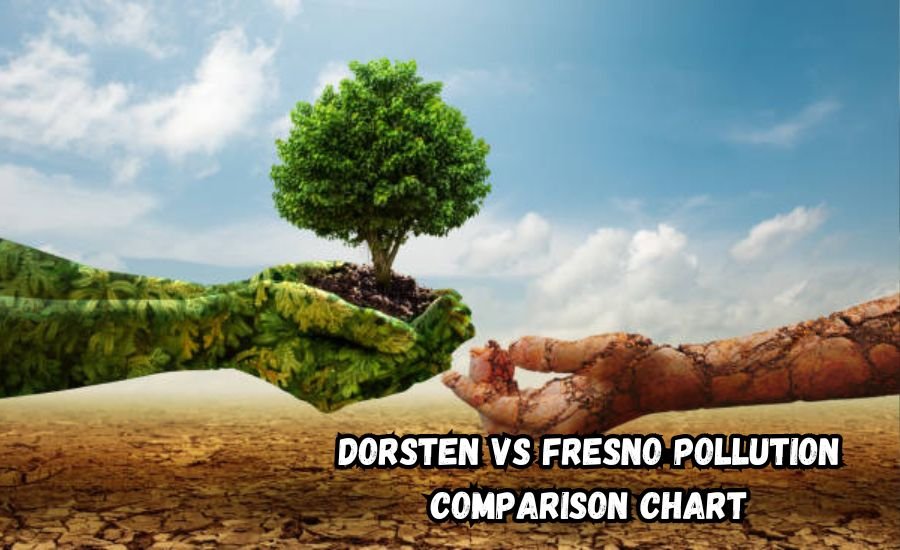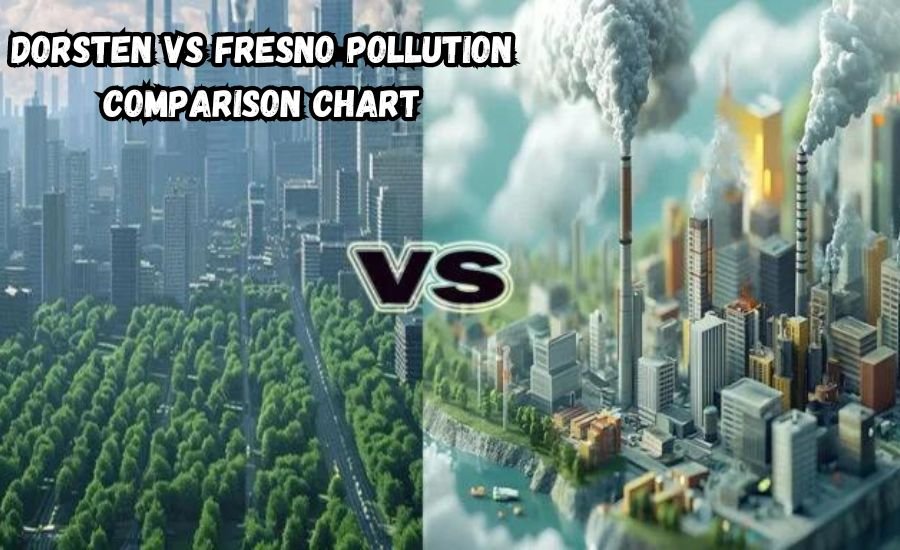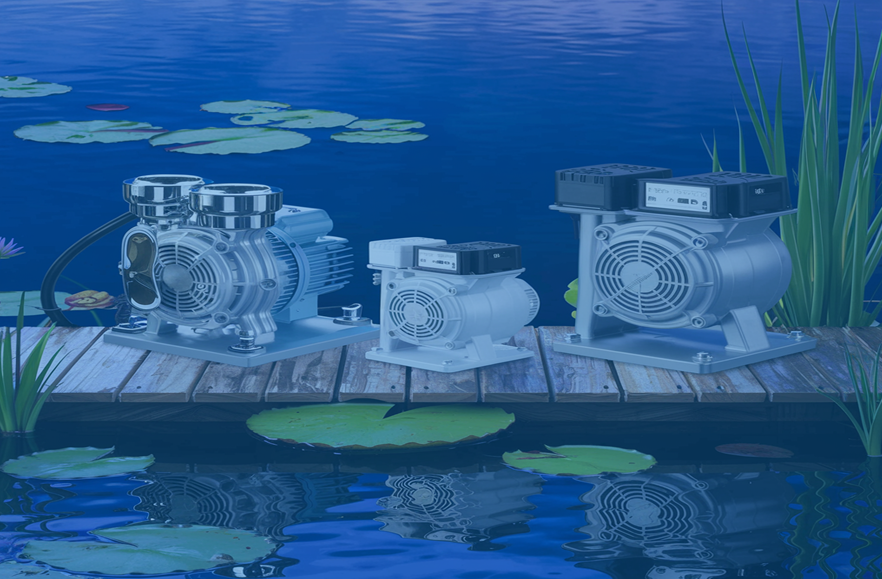Dorsten vs Fresno Pollution Comparison Chart: An In-Depth Analysis

Pollution doesn’t discriminate by location; both developed and developing regions suffer from its effects. In this Dorsten vs Fresno pollution comparison, we’ll examine how each city approaches this pressing issue. Dorsten is known for its historic industrial background and its location in the densely populated Ruhr area, while Fresno sits in California’s agriculturally rich but environmentally challenged Central Valley. The keyword “Dorsten vs Fresno pollution comparison chart” will guide this analysis as we compare air quality, water, waste management, and much more.
Geographical and Environmental Context
To truly understand the pollution dynamics in these two cities, we need to start with geography. Dorsten is located in the North Rhine-Westphalia region, close to major industrial hubs. This has contributed to higher pollution levels in the past. However, stringent environmental policies have helped mitigate these effects.
On the other hand, Fresno’s geographical positioning within California’s Central Valley makes it a hotspot for pollution. The valley traps air pollutants, leading to some of the worst air quality in the United States. Surrounding agriculture and a sprawling urban layout exacerbate these issues.
| Comparison Aspect | Dorsten | Fresno |
| Location | Industrial Region (Germany) | Agricultural Valley (USA) |
| Climate Influence | Moderate Rainfall, Disperses Pollutants | Hot Summers, Inversions Trap Pollutants |
Air Quality and Sources of Pollution
Dorsten’s Air Quality: Dorsten benefits from strict European Union emission standards. Air quality has improved over the years, especially with the decline of heavy industry. The primary sources of pollution in Dorsten now include vehicular emissions and industrial activities from nearby areas. However, its air quality is still relatively good due to consistent policy enforcement.
Fresno’s Air Quality: Fresno suffers from some of the worst air quality in the U.S., primarily due to agricultural practices, vehicle emissions, and its geographic location. The valley setting traps pollutants like nitrogen dioxide (NO2) and particulate matter (PM2.5), resulting in frequent smog. Despite various initiatives, such as promoting electric vehicles and stricter emissions standards, air quality remains a serious issue in Fresno.
| Comparison Aspect | Dorsten | Fresno |
| Main Pollutants | Industrial Emissions, Vehicles | Agriculture, Vehicles, Industrial |
| Air Quality Ranking | Moderate | Among the Worst in the U.S. |
| Regulations | Strict EU Standards | Struggling with Enforcement |
Water Pollution and Management
Water pollution is a critical issue globally, and both Dorsten and Fresno face challenges, albeit from different sources.
Dorsten’s Water Quality: Dorsten has a well-regulated water management system. Germany’s environmental laws ensure that industries treat wastewater before releasing it into rivers. Public water treatment facilities use advanced technologies to purify water, making it safe for consumption. Dorsten also has public awareness campaigns promoting water conservation.
Fresno’s Water Issues: In contrast, Fresno has significant water pollution issues stemming from agricultural runoff, which contaminates water supplies with nitrates, pesticides, and other harmful chemicals. Aging infrastructure also hampers efforts to ensure clean drinking water. Despite efforts to upgrade water systems and regulate agricultural pollution, many communities still suffer from unsafe water.
| Comparison Aspect | Dorsten | Fresno |
| Source of Pollution | Industrial Waste | Agricultural Runoff |
| Water Treatment | Advanced Facilities | Aging Infrastructure |
| Public Awareness | High | Moderate |
Waste Management Practices

Waste management plays a crucial role in reducing pollution. Let’s compare the systems in place in both cities:
Dorsten’s Waste Management: Germany is a global leader in waste management, and Dorsten benefits from this. Residents separate waste into recyclable, organic, and residual categories. The town has high recycling rates and has made strides in composting. Hazardous waste is disposed of properly, and waste-to-energy plants help reduce landfill use.
Fresno’s Waste Management: Fresno, like many American cities, struggles with recycling and waste management. Landfills are often overburdened, and illegal dumping remains a problem. Efforts to increase recycling rates and improve waste management have met with limited success, primarily due to funding constraints and a lack of public participation.
| Comparison Aspect | Dorsten | Fresno |
| Recycling Rate | High | Low |
| Public Participation | Strong | Limited |
| Landfill Usage | Low | High |
Impact on Health
The impact of pollution on public health is a key consideration in this Dorsten vs Fresno pollution comparison chart.
Dorsten’s Health Profile: Thanks to cleaner air and water, Dorsten’s residents generally enjoy better health outcomes. The rates of respiratory diseases, such as asthma and chronic bronchitis, are lower compared to other industrialized cities. Public health initiatives and strict environmental regulations contribute to this.
Fresno’s Health Profile: Fresno, by contrast, suffers from high rates of pollution-related health issues. The city ranks among the worst in the U.S. for childhood asthma rates, and respiratory diseases are common due to prolonged exposure to poor air quality. Vulnerable communities in Fresno face the most significant health risks, further exacerbated by limited healthcare access.
| Comparison Aspect | Dorst n | Fresno |
| Respiratory Illnesses | Low | High |
| Asthma Rates | Low | Among the Worst in the U.S. |
| Public Health Initiatives | Strong | Improving |
Regulations and Public Policies
Dorsten’s Environmental Policies: Germany’s strict environmental regulations apply to Dorsten as well. EU guidelines on vehicle emissions, industrial waste, and renewable energy adoption help keep pollution levels in check. Dorsten has also embraced renewable energy sources, further reducing its carbon footprint.
Fresno’s Regulations: While California has some of the most progressive environmental laws in the U.S., enforcement remains a challenge in Fresno. Agriculture and transportation industries have historically pushed back against stricter regulations, fearing economic repercussions. Although efforts to implement clean energy and sustainable farming are underway, progress is slow.
| Comparison Aspect | Dorsten | Fresno |
| Regulatory Strength | Strong | Moderate |
| Focus Areas | Industry, Transportation | Agriculture, Transportation |
| Renewable Energy Adoption | High | Growing |
Read Next: Finbusines
Technological Solutions

Both cities employ technology to mitigate pollution, but with differing levels of success.
Dorsten’s Technological Initiatives: Dorsten has embraced advanced technologies for pollution monitoring, such as air quality sensors and wastewater treatment plants. These technologies provide real-time data that allow authorities to act swiftly. Renewable energy projects, including solar and wind power, further aid in reducing pollution.
Fresno’s Technological Initiatives: Fresno has made strides in using technology to monitor pollution levels, particularly in air quality management. However, the adoption of green technologies, such as renewable energy and sustainable agriculture, lags due to budget constraints and political resistance.
| Comparison Aspect | Dorsten | Fresno |
| Air Quality Monitoring | Advanced | Growing |
| Renewable Energy Use | High | Moderate |
| Technological Investment | Strong | Limited |
Future Outlook and Challenges
The future of both cities depends heavily on continued innovation, regulation, and public participation.
Dorsten’s Outlook: Dorsten’s transition toward renewable energy and cleaner industrial practices positions it well for the future. However, continued vigilance is necessary, particularly with industrial pollution from neighboring regions.
Fresno’s Outlook: Fresno faces significant challenges in reducing pollution levels, but there is potential for improvement. Stronger regulatory frameworks, increased investment in clean technologies, and greater community involvement could help the city tackle its pollution problems.
| Comparison Aspect | Dorsten | Fresno |
| Challenges | Industrial Emissions | Agricultural, Vehicular Pollution |
| Opportunities | Renewable Energy | Regulatory Strengthening |
Conclusion: Key Takeaways from the Dorsten vs Fresno Pollution Comparison Chart
Through this Dorsten vs Fresno pollution comparison chart, we’ve explored several areas where these two cities differ in their approach to pollution. Dorsten benefits from stringent regulations and advanced technology, while Fresno grapples with more complex challenges, such as agricultural emissions and geographic limitations. However, with focused efforts, Fresno can adopt lessons from cities like Dorsten and make strides toward a cleaner environment.
FAQS
Q: What is the main cause of pollution in Dorsten?
A: The main causes of pollution in Dorsten are industrial emissions and vehicle exhaust, though strict regulations help control these levels.
Q: Why is Fresno’s air quality worse than Dorsten’s?
A: Fresno’s air quality is worse due to agricultural emissions, vehicle pollution, and its valley location, which traps pollutants.
Q: How does Dorsten manage waste effectively?
A: Dorsten has a highly efficient waste management system, focusing on recycling, composting, and proper disposal of hazardous materials.
Q: What are the health impacts of pollution in Fresno?
A: Fresno experiences high rates of asthma and respiratory diseases due to poor air quality caused by pollutants from agriculture and traffic.
Q: What technological solutions does Dorsten use to reduce pollution?
A: Dorsten uses advanced air quality monitoring systems, renewable energy projects, and modern wastewater treatment technologies.
Q: What is Fresno doing to improve its pollution levels?
A: Fresno is promoting public transportation, electric vehicle usage, and stricter agricultural practices to improve air quality and reduce pollution.
Q: How does geography affect pollution in Fresno?
A: Fresno’s location in a valley traps air pollutants, making it difficult for the city to disperse emissions, leading to prolonged poor air quality.
Uncover More Fresh Content About: Ford-F350-Part-Number-Fl34-894323-Price






